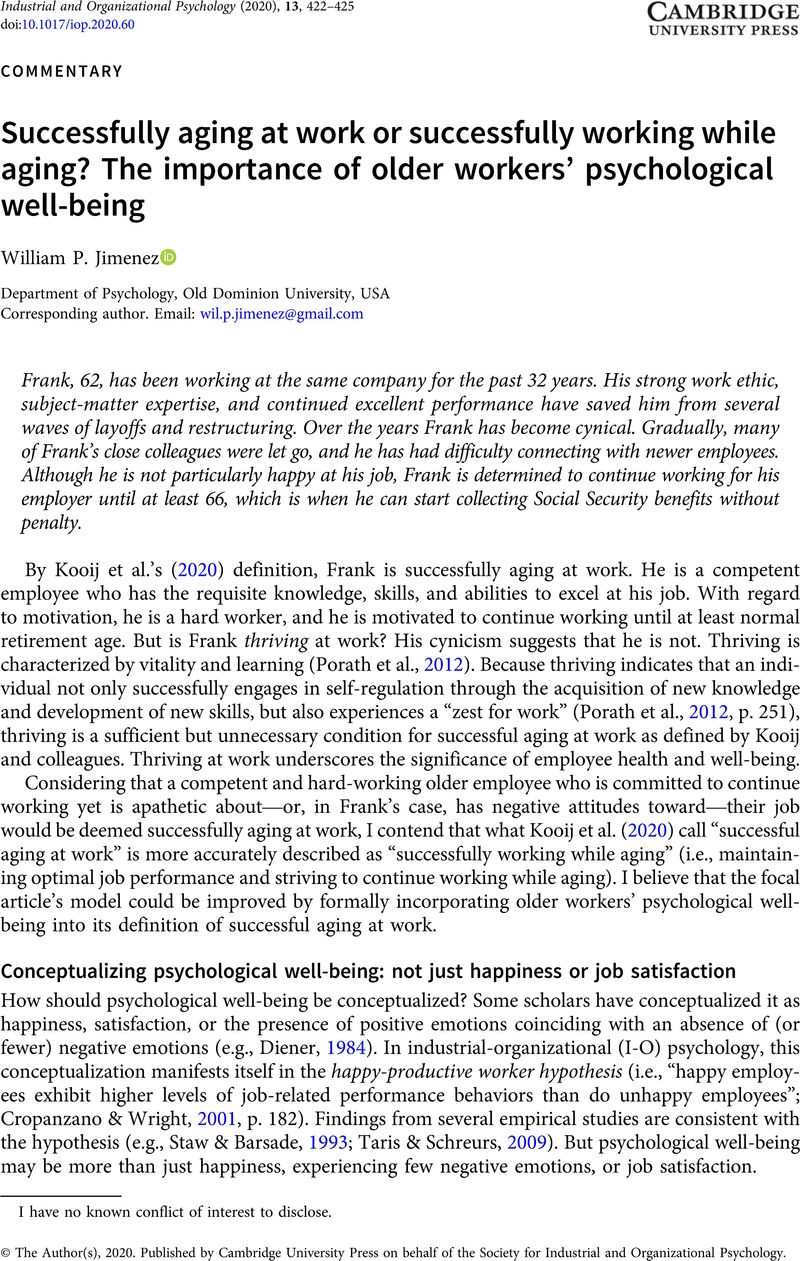No CrossRef data available.
Article contents
Successfully aging at work or successfully working while aging? The importance of older workers’ psychological well-being
Published online by Cambridge University Press: 11 November 2020
Abstract
An abstract is not available for this content so a preview has been provided. Please use the Get access link above for information on how to access this content.

- Type
- Commentaries
- Information
- Copyright
- © The Author(s), 2020. Published by Cambridge University Press on behalf of the Society for Industrial and Organizational Psychology.
Footnotes
I have no known conflict of interest to disclose.
References
Allan, B. A., Batz-Barbarich, C., Sterling, H. M., & Tay, L. (2019). Outcomes of meaningful work: A meta-analysis. Journal of Management Studies, 56(3), 500–528. https://doi.org/10.1111/joms.12406
CrossRefGoogle Scholar
Colbert, A. E., Bono, J. E., & Purvanova, R. K. (2016). Flourishing via workplace relationships: Moving beyond instrumental support. Academy of Management Journal, 59(4), 1199–1223. https://doi.org/10.5465/amj.2014.0506
CrossRefGoogle Scholar
Cropanzano, R., & Wright, T. A. (2001). When a “happy” worker is really a “productive” worker: A review and further refinement of the happy-productive worker thesis. Consulting Psychology Journal: Practice and Research, 53(3), 182–199. https://doi.org/10.1037/1061-4087.53.3.182
CrossRefGoogle Scholar
Demerouti, E., Bakker, A. B., de Jonge, J., Janssen, P. P. M., & Schaufeli, W. B. (2001). Burnout and engagement at work as a function of demands and control. Scandinavian Journal of Work, Environment & Health, 27(4), 279–286. https://doi.org/10.5271/sjweh.615
CrossRefGoogle ScholarPubMed
Diener, E. D. (1984). Subjective well-being. Psychological Bulletin, 95(3), 542–575. https://doi.org/10.1037/0033-2909.95.3.542
CrossRefGoogle ScholarPubMed
Dik, B. J., Byrne, Z. S., & Steger, M. F. (Eds.). (2013). Purpose and meaning in the workplace. American Psychological Association. https://doi.org/10.1037/14183-000
Google Scholar
De Wind, A., Leijten, F. R. M., Hoekstra, T., Geuskens, G. A., Burford, A., & van der Beek, A. J. (2017). “Mental retirement?” Trajectories of work engagement preceding retirement among older workers. Scandinavian Journal of Work, Environment, & Health, 43(1), 34–41. https://doi.org/10.5271/sjweh.3604
CrossRefGoogle ScholarPubMed
Fredrickson, B. L. (2000). Why positive emotions matter in organizations: Lessons from the broaden-and-build model. Psychologist-Manager Journal, 4(2), 131–142. https://doi.org/10.1037/h0095887
CrossRefGoogle Scholar
Halbesleben, J. R. B. (2006). Sources of social support and burnout: A meta-analytic test of the conservation of resources model. Journal of Applied Psychology, 91(5), 1134–1145. https://doi.org/10.1037/0021-9010.91.5.1134
CrossRefGoogle ScholarPubMed
Hawkley, L. C., & Cacioppo, J. T. (2007). Aging and loneliness: Downhill quickly? Current Directions in Psychological Science, 16(4), 187–191. https://doi.org/10.1111/j.1467-8721.2007.00501.x
CrossRefGoogle Scholar
Hu, X., & Kaplan, S. (2015). Is “feeling good” good enough? Differentiating discrete positive emotions at work. Journal of Organizational Behavior, 36(1), 39–58. https://doi.org/10.1002/job.1941
CrossRefGoogle Scholar
Kern, M. L. (2014). The workplace PERMA profiler. http://www.peggykern.org/uploads/5/6/6/7/56678211/workplace_perma_profiler_102014.pdf
Google Scholar
Kooij, D. T. A. M., Tims, M., & Kanfer, R. (2015). Successful aging at work: The role of job crafting. In Bal, P. M., Kooij, D. T. A. M., & Rousseau, D. M. (Eds.), Aging workers and the employee-employer relationship (pp. 145–161). Springer.Google Scholar
Kooij, D. T. A. M, Zacher, H., Wang, M., & Heckhausen, J. (2020). Successful aging at work: A process model to guide future research and practice. Industrial and Organizational Psychology: Perspectives on Science and Practice, 13(3), 345–365. https://doi.org/10.1017/iop.2020.1
Google Scholar
Kun, Á., Balogh, P., & Krasz, K. G. (2017). Development of the Work-Related Well-Being Questionnaire based on Seligman’s PERMA model. Periodica Polytechnica Social and Management Sciences, 25(1), 56–63. https://doi.org/10.3311/PPso.9326
CrossRefGoogle Scholar
Lefkowitz, J. (2019). The conundrum of industrial-organizational psychology. Industrial and Organizational Psychology: Perspectives on Science and Practice, 12(4), 473–478. https://doi.org/10.1017/iop.2019.114
CrossRefGoogle Scholar
Neumeier, L. M., Brook, L., Ditchburn, G., & Sckopke, P. (2017). Delivering your daily dose of well-being to the workplace: A randomized controlled trial of an online well-being programme for employees. European Journal of Work and Organizational Psychology, 26(4), 555–573. https://doi.org/10.1080/1359432X.2017.1320281
CrossRefGoogle Scholar
Ong, A. D. (2010). Pathways linking positive emotion and health in later life. Current Directions in Psychological Science, 19(6), 358–362. https:/doi.org/10.1177/0963721410388805
CrossRefGoogle Scholar
Porath, C., Spreitzer, G., Gibson, C., & Garnett, F. G. (2012). Thriving at work: Toward its measurement, construct validation, and theoretical refinement. Journal of Organizational Behavior, 33(2), 250–275. https://doi.org/10.1002/job.756
CrossRefGoogle Scholar
Posthuma, R. A., & Campion, M. A. (2009). Age stereotypes in the workplace: Common stereotypes, moderators, and future research directions. Journal of Management, 35(1), 158–188. https://doi.org/10.1177/0149206308318617
CrossRefGoogle Scholar
Seligman, M. (2018). PERMA and the building blocks of well-being. Journal of Positive Psychology, 13(4), 333–335. https://doi.org/10.1080/17439760.2018.1437466
CrossRefGoogle Scholar
Seligman, M. E. P. (2011). Flourish: A visionary new understanding of happiness and well-being. Simon & Schuster.Google Scholar
Staw, B. M., & Barsade, S. G. (1993). Affect and managerial performance: A test of the sadder-but-wiser vs. happier-and-smarter hypotheses. Administrative Science Quarterly, 38(2), 304–331. https://doi.org/10.2307/2393415
CrossRefGoogle Scholar
Taris, T. W., & Schreurs, P. J. G. (2009). Well-being and organizational performance: An organizational-level test of the happy-productive worker hypothesis. Work & Stress, 23(2), 120–136. https://doi.org/10.1080/02678370903072555
CrossRefGoogle Scholar
Van den Broeck, A., Vansteenkiste, M., De Witte, H., Soenens, B., & Lens, W. (2010). Capturing autonomy, competence, and relatedness at work: Construction and initial validation of the Work-related Basic Need Satisfaction scale. Journal of Occupational and Organizational Psychology, 83(4), 981–1002. https://doi.org/10.1348/096317909X481382
CrossRefGoogle Scholar
Watanabe, K., Kawakami, N., Shiotani, T., Adachi, H., Matsumoto, K., Imamura, K., Yamagami, F., Fusejima, A., Muraoka, T., Kagami, T., Shimazu, A., & Kern, M. L. (2018). The Japanese workplace PERMA-profiler: A validation study among Japanese workers. Journal of Occupational Health, 60(5), 383–393. https://doi.org/10.1539/joh.2018-0050-OA
CrossRefGoogle ScholarPubMed




